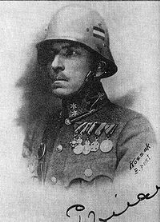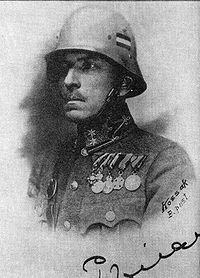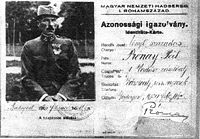
Pál Prónay
Encyclopedia

Reactionary
The term reactionary refers to viewpoints that seek to return to a previous state in a society. The term is meant to describe one end of a political spectrum whose opposite pole is "radical". While it has not been generally considered a term of praise it has been adopted as a self-description by...
and paramilitary commander in the years following the First World War
World War I
World War I , which was predominantly called the World War or the Great War from its occurrence until 1939, and the First World War or World War I thereafter, was a major war centred in Europe that began on 28 July 1914 and lasted until 11 November 1918...
. He is considered to have been the most brutal of the Hungarian National Army officers who led the White Terror
White Terror (Hungary)
The White Terror in Hungary was a two-year period of repressive violence by counter-revolutionary soldiers, with the intent of crushing any vestige of Hungary’s brief Communist revolution. Many of its victims were Jewish.-Background:...
that followed Hungary’s brief 1919 Communist coup d'état
Hungarian Soviet Republic
The Hungarian Soviet Republic or Soviet Republic of Hungary was a short-lived Communist state established in Hungary in the aftermath of World War I....
.
Background
The Hungarian people considered themselves humiliated and dismembered by the victors of the First World WarWorld War I
World War I , which was predominantly called the World War or the Great War from its occurrence until 1939, and the First World War or World War I thereafter, was a major war centred in Europe that began on 28 July 1914 and lasted until 11 November 1918...
. The Entente Powers stripped away
Treaty of Trianon
The Treaty of Trianon was the peace agreement signed in 1920, at the end of World War I, between the Allies of World War I and Hungary . The treaty greatly redefined and reduced Hungary's borders. From its borders before World War I, it lost 72% of its territory, which was reduced from to...
two-thirds of the nation’s territory and awarded them to Hungary’s neighbors. With the lands went one-third of the country's Hungarian-speaking nationals.
Humiliation was inflamed by political instability. The first post-war attempt at a democratic government, under prime minister Mihaly Karolyi
Mihály Károlyi
Count Mihály Ádám György Miklós Károlyi de Nagykároly was briefly Hungary's leader in 1918-19 during a short-lived democracy...
, floundered and was overthrown in March 1919 by a Communist coup. Its leader, Béla Kun
Béla Kun
Béla Kun , born Béla Kohn, was a Hungarian Communist politician and a Bolshevik Revolutionary who led the Hungarian Soviet Republic in 1919.- Early life :...
, had Jewish roots and Soviet training. Popular at first, Kun’s so-called Hungarian Soviet Republic
Hungarian Soviet Republic
The Hungarian Soviet Republic or Soviet Republic of Hungary was a short-lived Communist state established in Hungary in the aftermath of World War I....
quickly lost the approval of the people, principally because of its failed economic policies, its inept military efforts to reclaim lost Hungarian lands from Czechoslovakia
Czechoslovakia
Czechoslovakia or Czecho-Slovakia was a sovereign state in Central Europe which existed from October 1918, when it declared its independence from the Austro-Hungarian Empire, until 1992...
and Romania
Romania
Romania is a country located at the crossroads of Central and Southeastern Europe, on the Lower Danube, within and outside the Carpathian arch, bordering on the Black Sea...
, and the Red Terror
Red Terror (Hungary)
The Red Terror in Hungary was a series of atrocities aimed at crushing political rivals during the four-month regime of the Hungarian Soviet Republic in 1919. It was so named because of its similarity to the Red Terror in Soviet Russia in both purpose and effect...
, in which Bolshevik-style gangs of young leather-clad thugs beat and murdered hundreds of the regime’s “bourgeois” or counter-revolutionary opponents.
The National Army
An alternative government struggled to form in the south of Hungary and secure the approval of the EntenteAllies of World War I
The Entente Powers were the countries at war with the Central Powers during World War I. The members of the Triple Entente were the United Kingdom, France, and the Russian Empire; Italy entered the war on their side in 1915...
powers; military affairs were placed in the hands of the former commander of the Austro-Hungarian fleet, Admiral Miklos Horthy
Miklós Horthy
Miklós Horthy de Nagybánya was the Regent of the Kingdom of Hungary during the interwar years and throughout most of World War II, serving from 1 March 1920 to 15 October 1944. Horthy was styled "His Serene Highness the Regent of the Kingdom of Hungary" .Admiral Horthy was an officer of the...
, who forged a counter-revolutionary force and called it the National Army.
Horthy called for Hungarian officers to join; Pál Prónay was one of the first.
Prónay was born in 1875 to a minor gentry family in the town of Romhany, in northern Hungary. He attended the Lahne Military Institute, but advanced slowly in his officer’s career, in part because he was abusive and violent toward his own men.

Gyula Gömbös
Gyula Gömbös de Jákfa was the conservative prime minister of Hungary from 1932 to 1936.-Background:Gömbös was born in the Tolna County village of Murga, Hungary, which had a mixed Hungarian and ethnic German population. His father was the village schoolmaster. The family belonged to the ...
, the right-wing politician and future prime minister.
In the summer of 1919, Prónay formed the first partisan militia of what would later be called the “White Guard.” As the National Army moved through the countryside and gathered momentum, Prónay and other officers began a two-year campaign of anti-Communist reprisals which are now known as the White Terror
White Terror (Hungary)
The White Terror in Hungary was a two-year period of repressive violence by counter-revolutionary soldiers, with the intent of crushing any vestige of Hungary’s brief Communist revolution. Many of its victims were Jewish.-Background:...
. Their goals were to exact revenge for the Communists’ transgressions – and to frighten a restless and volatile population into submitting to the counter-revolutionary government's control. Prónay also sought to “restore the traditional good relations between the landlords and estate servants,” which in essence meant enforcing obedience by the Hungarian servant class.
The White Terror
Prónay's name is essentially synonymous with the cruelty of the worst White Terror reprisals. He selected his targets from among Communists, Social Democrats (Hungary's second Marxist political party), peasants, and Jews, whom many in the National Army blamed wholesale for the failed and bloody Communist coup d'état because 55–75% of its leaders were Jewish. Unlike some agents of terror, Prónay never saw any need to disguise or mitigate his acts of torture and humiliation, and in his later writings, he described them with undimmed relish. His unit kidnapped and blackmailed Jewish merchants and hacked off the breasts of peasant and Jewish women. They slashed off the ears of their victims to keep as trophies, and fed the boiler of the battalion’s armored train with the bodies of their prisoners, some of them alive.Prónay and his men liked to bring a demonic creativity to their humiliations. They sprinkled powdered sugar onto the battered and swollen faces of the men they bludgeoned, so as to attract hundreds of flies; they fastened leashes of string to their prisoners’ genitals and then whipped them to run in circles; and they tied their victims into stables and forced them eat hay.
Although technically soldiers in the National Army, Prónay’s men did not follow the standard chain of command. Prónay demanded, and received, suicidal loyalty to himself; soldiers were expected to follow the most brutal orders without hesitation, and those who had no stomach for these activities were expunged from the unit.
The Soviet Republic collapsed in August 1919, as the invading Romanian army (supported by French occupational troops) reached the Hungarian capital, Budapest
Budapest
Budapest is the capital of Hungary. As the largest city of Hungary, it is the country's principal political, cultural, commercial, industrial, and transportation centre. In 2011, Budapest had 1,733,685 inhabitants, down from its 1989 peak of 2,113,645 due to suburbanization. The Budapest Commuter...
. Kun and his allies fled, and the White Terror intensified.
The savagery of the White Terror
White Terror (Hungary)
The White Terror in Hungary was a two-year period of repressive violence by counter-revolutionary soldiers, with the intent of crushing any vestige of Hungary’s brief Communist revolution. Many of its victims were Jewish.-Background:...
cannot be blamed on Prónay alone. Other commanders, notably Ivan Hejjas, Gyula Ostenberg and Anton Lehár
Anton Lehár
Anton Freiherr von Lehár was an Austrian officer of Hungarian descent, who reached the pinnacle of his service after World War I when he supported the former Emperor Charles I of Austria's attempts to retake the throne of Hungary...
, led similar squadrons and committed similar brutalities. But Prónay seems to have outdone these colleagues in both fanaticism and cruelty.
In November 1919, Romanian troops withdrew. When Horthy and the National Army consolidated their control over the capital and the nation, Pronay installed his unit in Hotel Britannia, where the group grew to battalion level. The program of vicious attacks continued; their plan included a city-wide pogrom
Pogrom
A pogrom is a form of violent riot, a mob attack directed against a minority group, and characterized by killings and destruction of their homes and properties, businesses, and religious centres...
until Horthy put a stop to it. In his diary, Prónay reported that Horthy
Prónay’s career ends
After the establishment of the Kingdom of Hungary, the terror continued. But tolerance for the reactionary violence was waning in the corridors of power. The White Guard units, particularly Prónay’s, were increasingly difficult to control, behaving less like army units and more like self-serving renegade gangs. Their savagery was outraging Hungary’s upper class, and drawing negative international press; it may also have hardened the feelings of the Entente powers toward Hungary at a crucial moment, just before the ratification of the Trianon Treaty.Nevertheless, it was at least another year before the terror died down. In the summer of 1920, Horthy’s government took measures to rein in and eventually disperse the reactionary battalions. Prónay managed to undermine these anti-White Guard measures, but only for a short time.
After Prónay’s men were implicated in the murder of a Budapest policeman in November 1920, his bosses’ permissiveness declined sharply. The following summer, Pronay was put on trial for extorting a wealthy Jewish politician, and for “insulting the President of the Parliament” by trying to cover up the extortion. Found guilty on both charges, Prónay was now a liability and an embarrassment. His command was revoked, and he was denounced as a common criminal on the floor of the Hungarian parliament.
After serving short sentences, Prónay tried to convince Horthy to restore his battalion command. The regent turned him down. Furious with his former patron, whom he now condemned as a useless windbag, Prónay moved to the Austrian border, where he continued his atrocities, and proclaimed himself Supreme Leader of a buffer state (the Banat of Leitha). Finally, in the fall of 1921, Prónay joined in the second failed attempt to oust Horthy and restore the Habsburg Charles IV, to the throne. Horthy at last permanently severed his ties with Prónay.
The Prónay Battalion lingered for a few months more under the command of a junior officer, but the government officially dissolved the unit in January 1922 and expelled its members from the army.
Prónay entered politics as a member of the government's right-wing opposition. In the 1930s, he sought and failed to emulate the Nazis by generating a Hungarian fascist mass movement. In 1932, he was charged with incitement, sentenced to six months in prison and stripped of his rank of lieutenant colonel.
In October 1944, as Budapest descended into chaos at the end of the Second World War, 69-year-old Prónay assembled a death squad and resumed his hunt for the old objects of his hatred, Hungarian Jews. He vanished in the war’s final weeks, and is believed to have fallen during the siege of Budapest
Battle of Budapest
The Siege of Budapest centered on the Hungarian capital city of Budapest. It was fought towards the end of World War II in Europe, during the Soviet Budapest Offensive. The siege started when Budapest, defended by Hungarian and German troops, was first encircled on 29 December 1944 by the Red Army...
.
Sources
- Magyar életrajzi lexikon (in Hungarian)

